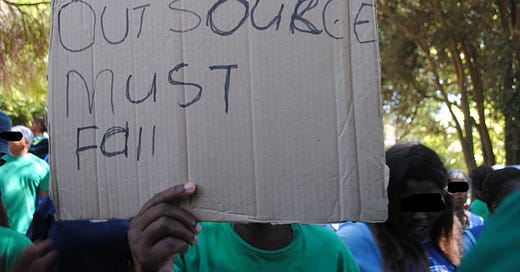In February of 2016 I was in a visual history classroom with my old MA supervisor. It was at the height of fees must fall protests at the University of the Western Cape. I was in one of the meeting rooms in the research center, and we could see out of the window to the lawn between two main teaching buildings. I knew there were possibly protests going on that day. Outsourced staff, mostly cleaning and grounds staff at the university, had joined the students in calling for an end to the oppressive university fees structure and the unfair labour conditions caused by the practice of outsourcing and the absolute abuse of support staff who occupy those kinds of roles.
I saw crowds gathering at one end of the lawn, people I knew and didn’t know, but I also saw our elders, the outsourced staff, join in with the gathering of mostly students. At the other end of the lawn, at the b-block building as we call it, there were a line of people in black armoured suits with helmets and paintball guns filled with a peppery powder. The private, outsourced, security service were there and waiting on the protesting crowd. I immediately packed up my things, apologised to my professor, and ran out of the class to join them.
This photo happened on that day, and I have been trying to consider what exposure meant since then. What does it mean to expose when the person being exposed is part of a structure making violence? When it is a black man who is an underpaid foot soldier of a security apparatus that exploits their labour for these acts of violence on students and workers, workers who don’t earn a living wage? He himself deployed on a salary that he can barely adequately support himself on. He was also, at least anecdotally, known to be an immigrant in South Africa, a country with vast recent history of xenophobia especially towards African migrants and immigrants. So what would it mean to expose this person?
It is not a perfect photo, but it is a good one. A little bright in places. A little unbalanced maybe. The luck of it all to see him seeing me in that moment, in front of the great hall where so many of us have graduated, in front of the signs pointing to the law and education faculty buildings, the luck of the meaning being made in layers here. Those days on campus were extremely violent, with police and private security forces coming at us from all sides at the request of the university management and administration. Campus barricaded and access only granted to some under certain circumstances.
Why do I feel so conflicted, then, about sharing this photograph in full, to anyone at all? Only a hand full of people have seen it. Me and my instagram page where I have posted any variety of photograph, but for some reason would never, absolutely never consider posting this one. What does it mean to be exposed? To be so hyper exposed and rendered absolutely visible and on display on the internet, a deployed foot soldier of the violence of state and institution, brandishing riot gear and paintball guns, some with rubber bullets, some with pepper spray. Why does it feel like a betrayal to share the face of this man enacting so much violence on the student and worker populace on my campus?
I suspect part of that discomfort lies in the fact that he is a black man and an immigrant, but there was something in his face and eyes in that moment that also made me stop and wonder about him and his life and the possible consequences of a single image gaining popularity. I also think there is something in the fact that he was not with the police, but deployed as part of a for hire army, a security firm bent on quashing all dissent. The state deploys individuals, individuals who then get subsumed in the work of the state and capital, folded into its action, sordidly dancing together in an entangled requiem on violent suppression. What is exposure, then, in this context? I wanted to declare this man an agent of the state and capital’s reactionary violence against students and workers, an outed actor, laid bare in a public discourse on the actions of himself and his colleagues in the name of suppression of dissent and dissatisfaction. A protest he might be a part of on another occasion. Is it an adequate response, or is it a disproportionate one?
On this same day I was hit in the face by a white security officer, he tried to grab the camera from me, pepper sprayed me and in the back and forth, pepper sprayed himself as well, all the while calling me a “poes” and swearing that he will have me arrested. He ran one way to get his eyes rinsed out, I went in to rejoin the workers and students at the Unibell train station where we would gather and talk and organize further.
My question here is only who gets to choose what and who to expose, and when. I have 0 qualm sharing publicly the image of the security guard who assaulted me for no reason that day, but somehow, there has been a years long nagging question at the core of me every time I look at the unedited, uncensored version of this image. Who is this man? What is his class position? How would exposure here render him? It is an internal conflict that I want to continue to consider and hold as we watch the unfolding and unrelenting documenting of every act. I want to continue to consider it because our exposures, perhaps well intended, perhaps journalistic, perhaps purely for vengeance, are now more permanent fixtures on an internet that can manipulate and distort beyond any meaning we may have ever intended.





